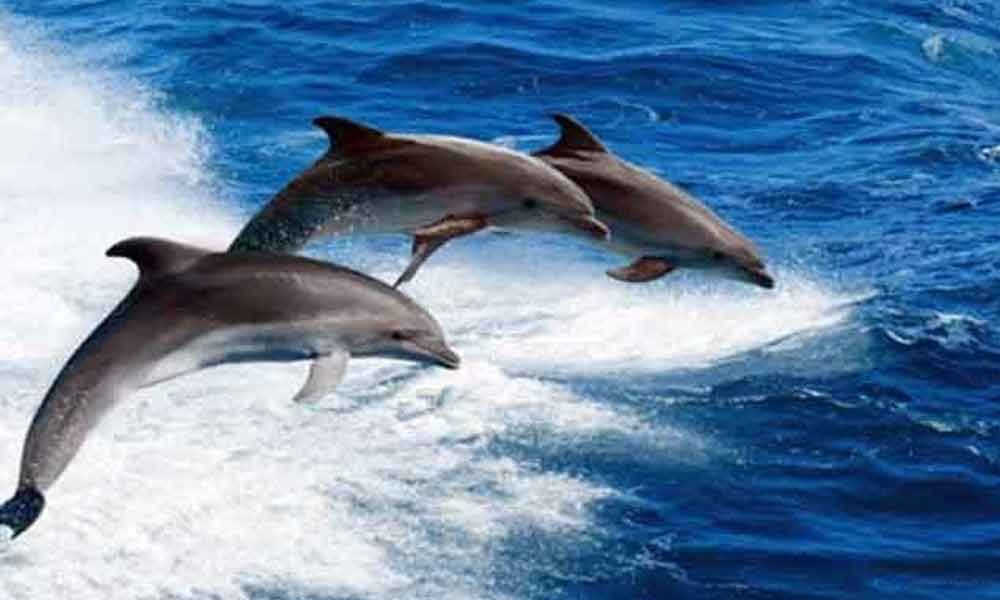Live
- Dilip Ray BJP candidate for Rourkela Assembly seat
- Mahindra unveils new nine-seater Bolero Neo+ starting at Rs 11.39 lakh
- UK unemployment rate jumps by more than expected as job market cools
- Gujarat Congress head Gohil criticizes Rupala's apology as insincere
- UPSC declares Civil Services 2023 results, Aditya Srivastava secures top rank
- BJP names three more candidates in Punjab
- Morgan Stanley does not expect RBI to go for a rate cut in 2024-25
- Karnataka tribal woman dies suspiciously in Sudan
- Battle for Jaunpur: Two ex-ministers and a don’s wife in the fray
- Bihar Cricket Association forms Women's Cricket Development Committee to empower female players
Just In
After 8-years delay, India to get 1st dolphin research centre in October


The foundation stone of India's first dolphin research centre will be laid here on October 5, after an eight-year delay since it was first mooted, an officer confirmed.
Patna : The foundation stone of India's first dolphin research centre will be laid here on October 5, after an eight-year delay since it was first mooted, an officer confirmed.
D.K. Shukla, the senior officer from Bihar's Department of Environment, Forest and Climate Change, said: "It was announced by Deputy Chief Minister Sushil Kumar Modi in state Assembly that Chief Minister Nitish Kumar would lay the foundation stone of the National Dolphin Research Centre (NDRC) on October 5 on the bank of river Ganga in the premises of Patna University."
Shukla said the development was a good news for conservation of the endangered Gangetic river dolphins in the country. According to Gopal Sharma, a senior scientist at the Zoological Survey of India (ZSI), the population of the endangered Gangetic river dolphins was stable along nearly 1,000 km stretch of the Ganga and its two major tributaries, Gandak and Ghaghra.
More than 1,500 dolphins were spotted by three teams of experts and scientists who undertook the exercise of enumeration of the species earlier this year.
The NDRC will play an important role to strengthen conservation efforts and help in research to save the endangered mammal.
Another officer of the Department SAID the NDRC remained stuck for over four years due to refusal of Patna University to part with its land for it.
Unhappy over the delay, Nitish Kumar threatened last year that the NDRC might be shifted to Bhagalpur. After this, the varsity finally gave its clearance.
A well reputed expert on the Gangetic river dolphins, R.K. Sinha, who is also the current Vice Chancellor of the Nalanda Open University in Patna said the NDRC will prove a boon for research and conservation of dolphin.
"It will help in reserach as well as conservation of dolphins." It was Sinha's idea to set up the NDRC in Patna and a proposal was approved by then Planning Commission Chairman Montek Singh Ahulwalia during his visit here in mid 2011 and early 2012.
Within a year, the commission had sanctioned Rs 28.06 crore for the NDRC in 2013 followed by the state government that also released Rs 18,16 crore to the Infrastructure Development Authority in 2014. But till July 2018, the NDRC remained a non-starter.
Sinha, known as the 'Dolphin Man' for his research of the Gangetic dolphins, said the species habitat has been threatened and disturbed in the river.
He said the Gangetic river dolphin is India's national aquatic animal but frequently falls prey to poachers and sometimes killed without intention after being trapped in fishs net and hit by machines.
The mammals are killed at an alarming rate with wildlife officials saying poachers kill them for their flesh, fat and oil. Sinha, who was conferred the Padma Shri for his research on dolphin, said dolphin presence is the sign of a healthy river ecosystem.
Dolphins prefer water that is at least 5ft to 8ft deep. They are usually found in turbulent waters, where there are enough fish for them to feed on.Gangetic dolphins live in a zone where there is little or no current, which helps them save energy. If they sense danger, they can dive into deeper waters.
The dolphins swim from the no-current zone to the edges to hunt for fish and return, Sinha added.
Gangetic river dolphins fall under Schedule I of the Indian Wildlife (Protection) Act, and have been declared an endangered species by the International Union for Conservation of Nature (IUCN).

© 2024 Hyderabad Media House Limited/The Hans India. All rights reserved. Powered by hocalwire.com






